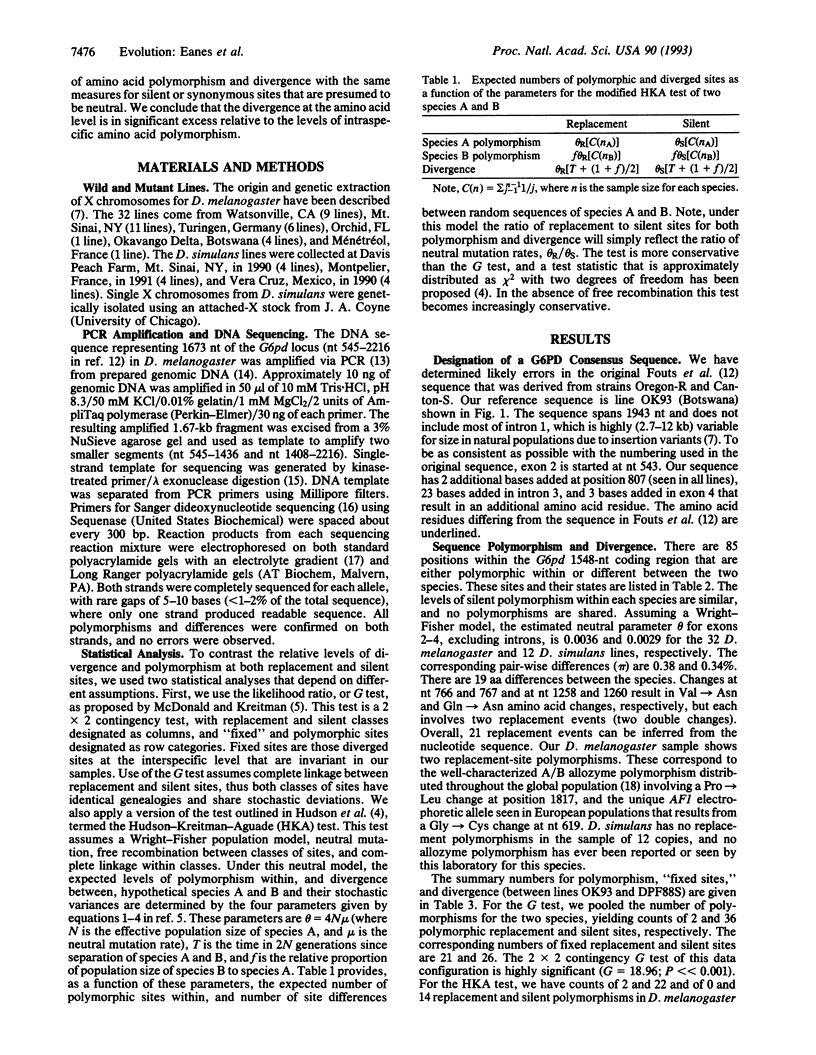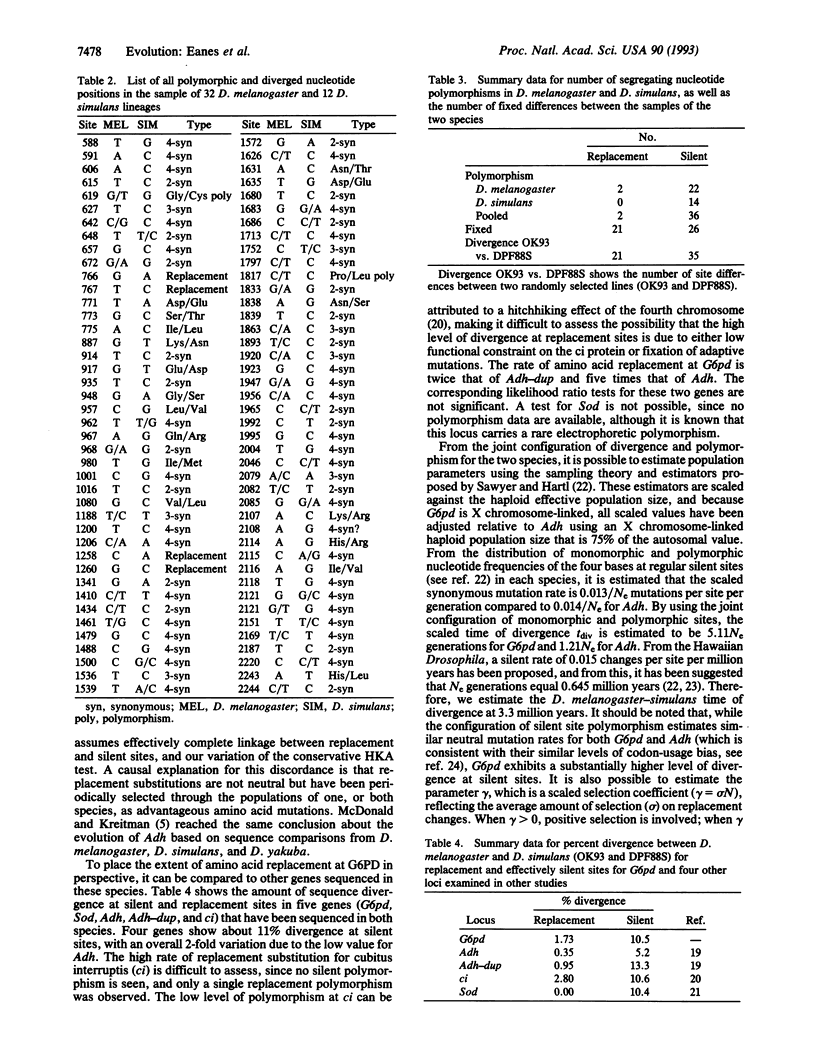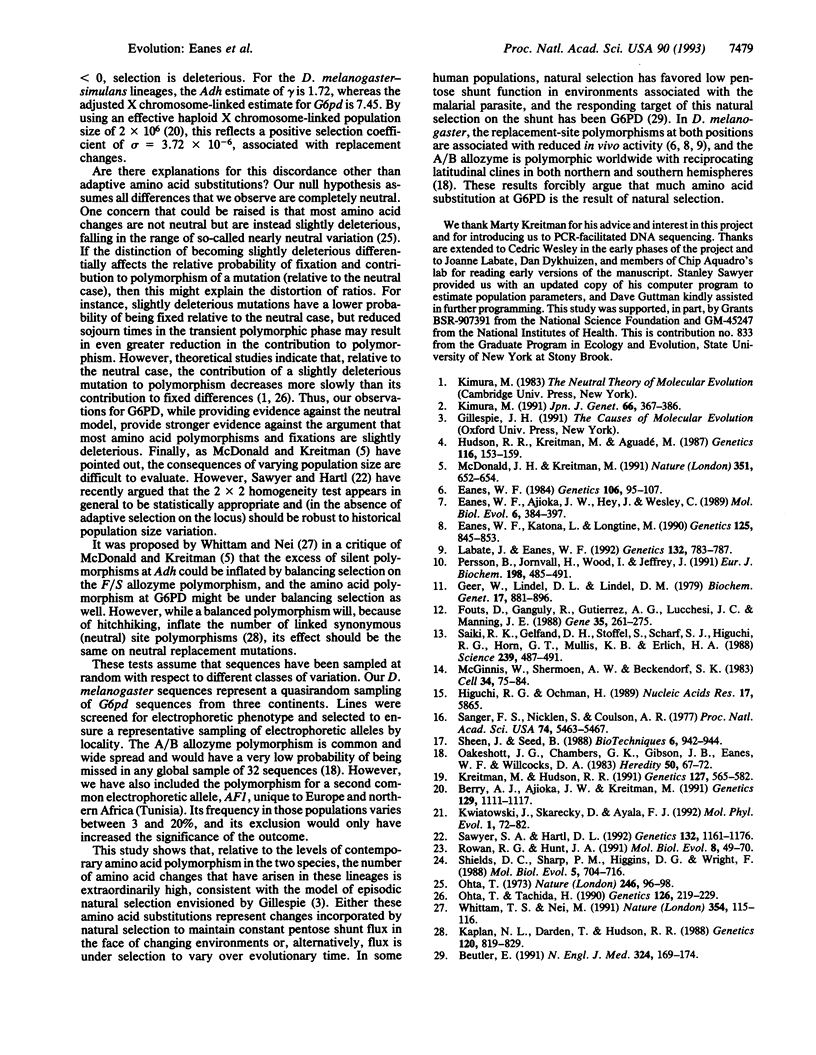Abstract
Proponents of the neutral theory argue that evolution at the molecular level largely reflects a process of random genetic drift of neutral mutations. Under this theory, levels of interspecific divergence and intraspecific polymorphism are expected to be correlated across classes of nucleotide or amino acid sequences with different degrees of functional constraint, such as synonymous and replacement sites. Nucleotide sites with reduced polymorphism should show comparably reduced levels of interspecific divergence. To examine this hypothesis, we have sequenced 32 and 12 copies of the glucose-6-phosphate dehydrogenase (G6pd) gene in Drosophila melanogaster and Drosophila simulans, respectively. Both species exhibit similar levels of nucleotide polymorphism at synonymous sites. D. melanogaster shows two amino acid polymorphisms, one associated with the cosmopolitan allozyme polymorphism and a second with an allozyme polymorphism endemic to European and North African populations. In contrast, D. simulans shows no replacement polymorphism. While synonymous divergence between species is 10%, which is typical of other genes, there are 21 replacement differences. This level of amino acid sequence divergence, when contrasted with levels of amino acid polymorphism, silent polymorphism, and divergence, is in 10-fold excess over that expected under the neutral model of molecular evolution. We propose that this excess divergence reflects episodes of natural selection on G6pd resulting in fixation of advantageous amino acid mutations in these two recently separated lineages.
Full text
PDF




Selected References
These references are in PubMed. This may not be the complete list of references from this article.
- Berry A. J., Ajioka J. W., Kreitman M. Lack of polymorphism on the Drosophila fourth chromosome resulting from selection. Genetics. 1991 Dec;129(4):1111–1117. doi: 10.1093/genetics/129.4.1111. [DOI] [PMC free article] [PubMed] [Google Scholar]
- Beutler E. Glucose-6-phosphate dehydrogenase deficiency. N Engl J Med. 1991 Jan 17;324(3):169–174. doi: 10.1056/NEJM199101173240306. [DOI] [PubMed] [Google Scholar]
- Eanes W. F., Ajioka J. W., Hey J., Wesley C. Restriction-map variation associated with the G6PD polymorphism in natural populations of Drosophila melanogaster. Mol Biol Evol. 1989 Jul;6(4):384–397. doi: 10.1093/oxfordjournals.molbev.a040555. [DOI] [PubMed] [Google Scholar]
- Eanes W. F., Katona L., Longtine M. Comparison of in vitro and in vivo activities associated with the G6PD allozyme polymorphism in Drosophila melanogaster. Genetics. 1990 Aug;125(4):845–853. doi: 10.1093/genetics/125.4.845. [DOI] [PMC free article] [PubMed] [Google Scholar]
- Eanes W. F. Viability interactions, in vivo activity and the G6PD polymorphism in Drosophila melanogaster. Genetics. 1984 Jan;106(1):95–107. doi: 10.1093/genetics/106.1.95. [DOI] [PMC free article] [PubMed] [Google Scholar]
- Fouts D., Ganguly R., Gutierrez A. G., Lucchesi J. C., Manning J. E. Nucleotide sequence of the Drosophila glucose-6-phosphate dehydrogenase gene and comparison with the homologous human gene. Gene. 1988 Mar 31;63(2):261–275. doi: 10.1016/0378-1119(88)90530-6. [DOI] [PubMed] [Google Scholar]
- Geer B. W., Lindel D. L., Lindel D. M. Relationship of the oxidative pentose shunt pathway to lipid synthesis in Drosophila melanogaster. Biochem Genet. 1979 Oct;17(9-10):881–895. doi: 10.1007/BF00504310. [DOI] [PubMed] [Google Scholar]
- Higuchi R. G., Ochman H. Production of single-stranded DNA templates by exonuclease digestion following the polymerase chain reaction. Nucleic Acids Res. 1989 Jul 25;17(14):5865–5865. doi: 10.1093/nar/17.14.5865. [DOI] [PMC free article] [PubMed] [Google Scholar]
- Hudson R. R., Kreitman M., Aguadé M. A test of neutral molecular evolution based on nucleotide data. Genetics. 1987 May;116(1):153–159. doi: 10.1093/genetics/116.1.153. [DOI] [PMC free article] [PubMed] [Google Scholar]
- Kaplan N. L., Darden T., Hudson R. R. The coalescent process in models with selection. Genetics. 1988 Nov;120(3):819–829. doi: 10.1093/genetics/120.3.819. [DOI] [PMC free article] [PubMed] [Google Scholar]
- Kimura M. The neutral theory of molecular evolution: a review of recent evidence. Jpn J Genet. 1991 Aug;66(4):367–386. doi: 10.1266/jjg.66.367. [DOI] [PubMed] [Google Scholar]
- Kreitman M., Hudson R. R. Inferring the evolutionary histories of the Adh and Adh-dup loci in Drosophila melanogaster from patterns of polymorphism and divergence. Genetics. 1991 Mar;127(3):565–582. doi: 10.1093/genetics/127.3.565. [DOI] [PMC free article] [PubMed] [Google Scholar]
- Kwiatowski J., Skarecky D., Ayala F. J. Structure and sequence of the Cu,Zn Sod gene in the Mediterranean fruit fly, Ceratitis capitata: intron insertion/deletion and evolution of the gene. Mol Phylogenet Evol. 1992 Mar;1(1):72–82. doi: 10.1016/1055-7903(92)90037-h. [DOI] [PubMed] [Google Scholar]
- Labate J., Eanes W. F. Direct measurement of in vivo flux differences between electrophoretic variants of G6PD from Drosophila melanogaster. Genetics. 1992 Nov;132(3):783–787. doi: 10.1093/genetics/132.3.783. [DOI] [PMC free article] [PubMed] [Google Scholar]
- McDonald J. H., Kreitman M. Adaptive protein evolution at the Adh locus in Drosophila. Nature. 1991 Jun 20;351(6328):652–654. doi: 10.1038/351652a0. [DOI] [PubMed] [Google Scholar]
- McGinnis W., Shermoen A. W., Beckendorf S. K. A transposable element inserted just 5' to a Drosophila glue protein gene alters gene expression and chromatin structure. Cell. 1983 Aug;34(1):75–84. doi: 10.1016/0092-8674(83)90137-x. [DOI] [PubMed] [Google Scholar]
- Oakeshott J. G., Chambers G. K., Gibson J. B., Eanes W. F., Willcocks D. A. Geographic variation in G6pd and Pgd allele frequencies in Drosophila melanogaster. Heredity (Edinb) 1983 Feb;50(Pt 1):67–72. doi: 10.1038/hdy.1983.7. [DOI] [PubMed] [Google Scholar]
- Ohta T. Slightly deleterious mutant substitutions in evolution. Nature. 1973 Nov 9;246(5428):96–98. doi: 10.1038/246096a0. [DOI] [PubMed] [Google Scholar]
- Ohta T., Tachida H. Theoretical study of near neutrality. I. Heterozygosity and rate of mutant substitution. Genetics. 1990 Sep;126(1):219–229. doi: 10.1093/genetics/126.1.219. [DOI] [PMC free article] [PubMed] [Google Scholar]
- Persson B., Jörnvall H., Wood I., Jeffery J. Functionally important regions of glucose-6-phosphate dehydrogenase defined by the Saccharomyces cerevisiae enzyme and its differences from the mammalian and insect forms. Eur J Biochem. 1991 Jun 1;198(2):485–491. doi: 10.1111/j.1432-1033.1991.tb16039.x. [DOI] [PubMed] [Google Scholar]
- Rowan R. G., Hunt J. A. Rates of DNA change and phylogeny from the DNA sequences of the alcohol dehydrogenase gene for five closely related species of Hawaiian Drosophila. Mol Biol Evol. 1991 Jan;8(1):49–70. doi: 10.1093/oxfordjournals.molbev.a040636. [DOI] [PubMed] [Google Scholar]
- Saiki R. K., Gelfand D. H., Stoffel S., Scharf S. J., Higuchi R., Horn G. T., Mullis K. B., Erlich H. A. Primer-directed enzymatic amplification of DNA with a thermostable DNA polymerase. Science. 1988 Jan 29;239(4839):487–491. doi: 10.1126/science.2448875. [DOI] [PubMed] [Google Scholar]
- Sanger F., Nicklen S., Coulson A. R. DNA sequencing with chain-terminating inhibitors. Proc Natl Acad Sci U S A. 1977 Dec;74(12):5463–5467. doi: 10.1073/pnas.74.12.5463. [DOI] [PMC free article] [PubMed] [Google Scholar]
- Sawyer S. A., Hartl D. L. Population genetics of polymorphism and divergence. Genetics. 1992 Dec;132(4):1161–1176. doi: 10.1093/genetics/132.4.1161. [DOI] [PMC free article] [PubMed] [Google Scholar]
- Sheen J. Y., Seed B. Electrolyte gradient gels for DNA sequencing. Biotechniques. 1988 Nov-Dec;6(10):942–944. [PubMed] [Google Scholar]
- Shields D. C., Sharp P. M., Higgins D. G., Wright F. "Silent" sites in Drosophila genes are not neutral: evidence of selection among synonymous codons. Mol Biol Evol. 1988 Nov;5(6):704–716. doi: 10.1093/oxfordjournals.molbev.a040525. [DOI] [PubMed] [Google Scholar]


